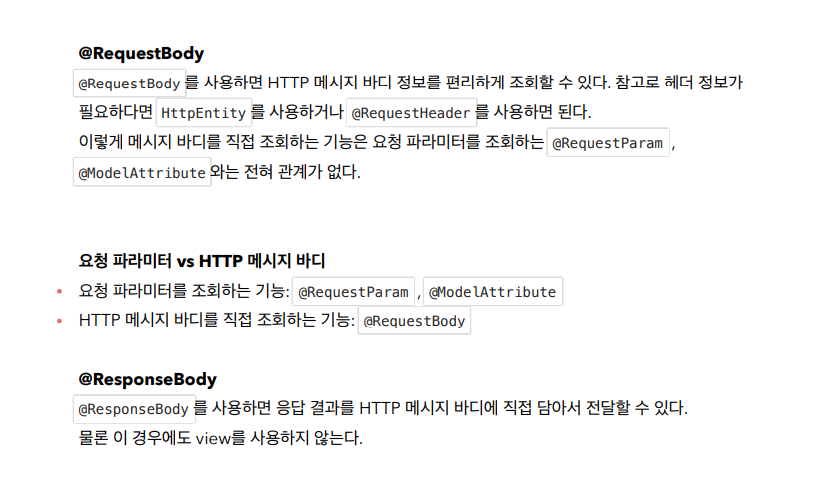<출처>
스프링 MVC 1편 - 백엔드 웹 개발 핵심 기술 /인프런 강의/ 김영한
HTTP 요청 - 기본, 헤더 조회
package hello.springmvc.basic.request;
import lombok.extern.slf4j.Slf4j;
import org.springframework.http.HttpMethod;
import org.springframework.util.MultiValueMap;
import org.springframework.web.bind.annotation.*;
import javax.servlet.http.HttpServletRequest;
import javax.servlet.http.HttpServletResponse;
import java.util.Locale;
@Slf4j
@RestController
public class RequestHeaderController {
@RequestMapping("/headers")
public String headers(HttpServletRequest request,
HttpServletResponse response,
HttpMethod httpMethod,
Locale locale,
@RequestHeader MultiValueMap<String, String>
headerMap,
@RequestHeader("host") String host,
@CookieValue(value = "myCookie", required = false)
String cookie
) {
log.info("request={}", request);
log.info("response={}", response);
log.info("httpMethod={}", httpMethod);
log.info("locale={}", locale);
log.info("headerMap={}", headerMap);
log.info("header host={}", host);
log.info("myCookie={}", cookie);
return "ok";
}
}


HTTP 요청 파라미터 - 쿼리 파라미터, HTML Form
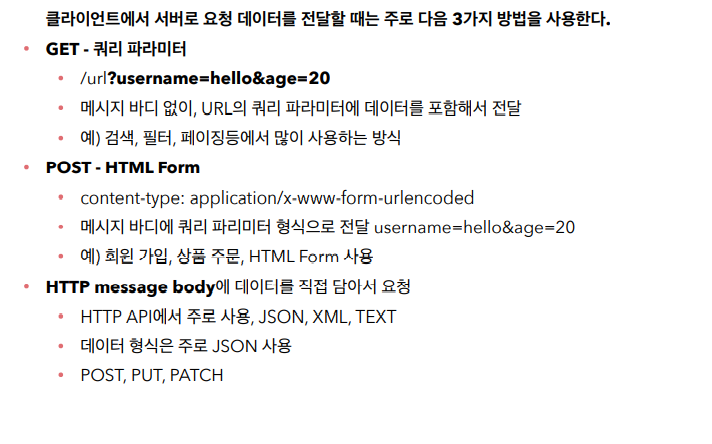
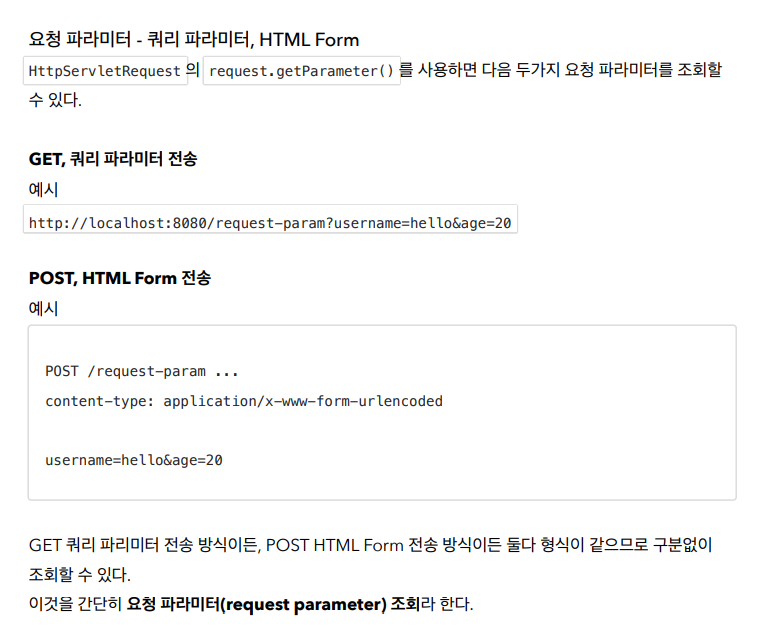
단순한 HttpServletRequest가 제공하는 방식으로 요청 파라미터를 조회
package hello.springmvc.basic.request;
import lombok.extern.slf4j.Slf4j;
import org.springframework.stereotype.Controller;
import org.springframework.web.bind.annotation.*;
import javax.servlet.http.HttpServletRequest;
import javax.servlet.http.HttpServletResponse;
import java.io.IOException;
import java.util.Map;
@Slf4j
@Controller
public class RequestParamController {
/**
* 반환 타입이 없으면서 이렇게 응답에 값을 직접 집어넣으면, view 조회X
*/
@RequestMapping("/request-param-v1")
public void requestParamV1(HttpServletRequest request, HttpServletResponse
response) throws IOException {
String username = request.getParameter("username");
int age = Integer.parseInt(request.getParameter("age"));
log.info("username={}, age={}", username, age);
response.getWriter().write("ok");
}
}
GET 실행
http://localhost:8080/request-param-v1?username=hello&age=20
HTTP 요청 파라미터 - @RequestParam
스프링이 제공하는 @RequestParam 을 사용하면 요청 파라미터를 매우 편리하게 사용할 수 있음
V2
/**
* @RequestParam 사용
* - 파라미터 이름으로 바인딩
* @ResponseBody 추가
* - View 조회를 무시하고, HTTP message body에 직접 해당 내용 입력
*/
@ResponseBody
@RequestMapping("/request-param-v2")
public String requestParamV2(
@RequestParam("username") String memberName,
@RequestParam("age") int memberAge) {
log.info("username={}, age={}", memberName, memberAge);
return "ok";
}
V3
/**
* @RequestParam 사용
* HTTP 파라미터 이름이 변수 이름과 같으면 @RequestParam(name="xx") 생략 가능
*/
@ResponseBody
@RequestMapping("/request-param-v3")
public String requestParamV3(@RequestParam String username, @RequestParam int age) {
log.info("username={}, age={}", username, age);
return "ok";
}
HTTP 파라미터 이름이 변수 이름과 같으면 @RequestParam(name="xx") 생략 가능
V4
/**
* @RequestParam 사용
* String, int 등의 단순 타입이면 @RequestParam 도 생략 가능
*/
@ResponseBody
@RequestMapping("/request-param-v4")
public String requestParamV4(String username, int age) {
log.info("username={}, age={}", username, age);
return "ok";
}String , int , Integer 등의 단순 타입이면 @RequestParam 도 생략 가능
파라미터 필수 여부 - requestParamRequired
/**
* @RequestParam.required
* /request-param -> username이 없으므로 예외
*
* 주의!
* /request-param?username= -> 빈문자로 통과
*
* 주의!
* /request-param
* int age -> null을 int에 입력하는 것은 불가능, 따라서 Integer 변경해야 함(또는 다음에 나오는
defaultValue 사용)
*/
@ResponseBody
@RequestMapping("/request-param-required")
public String requestParamRequired(
@RequestParam(required = true) String username,
@RequestParam(required = false) Integer age) {
log.info("username={}, age={}", username, age);
return "ok";
}
기본 값 적용 - requestParamDefault
/**
* @RequestParam
* - defaultValue 사용
*
* 참고: defaultValue는 빈 문자의 경우에도 적용
* /request-param?username=
*/
@ResponseBody
@RequestMapping("/request-param-default")
public String requestParamDefault(
@RequestParam(required = true, defaultValue = "guest") String username,
@RequestParam(required = false, defaultValue = "-1") int age) {
log.info("username={}, age={}", username, age);
return "ok";
}
파라미터를 Map으로 조회하기 - requestParamMap
/**
* @RequestParam Map, MultiValueMap
* Map(key=value)
* MultiValueMap(key=[value1, value2, ...] ex) (key=userIds, value=[id1, id2])
*/
@ResponseBody
@RequestMapping("/request-param-map")
public String requestParamMap(@RequestParam Map<String, Object> paramMap) {
log.info("username={}, age={}", paramMap.get("username"),
paramMap.get("age"));
return "ok";
}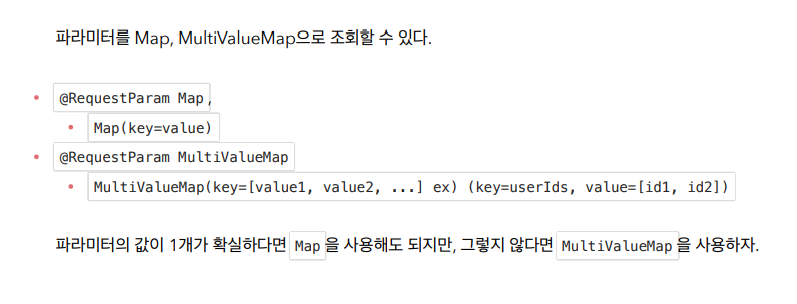
HTTP 요청 파라미터 - @ModelAttribute
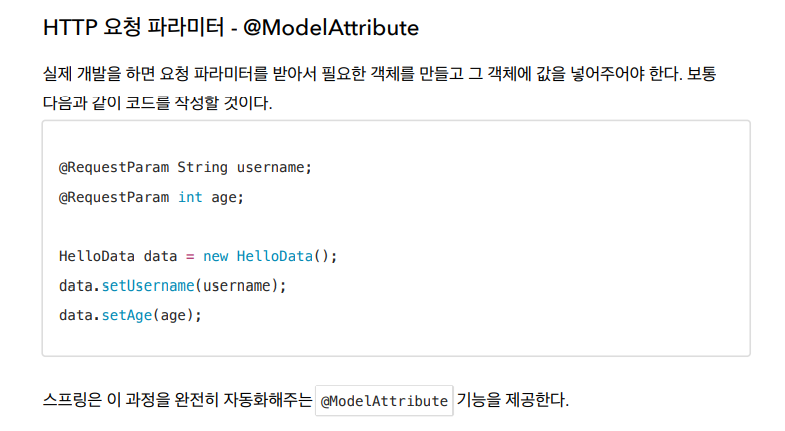

롬복 @Data
@Getter , @Setter , @ToString , @EqualsAndHashCode , @RequiredArgsConstructor 를
자동으로 적용해준다
@ModelAttribute 적용 - modelAttributeV1
/**
* @ModelAttribute 사용
* 참고: model.addAttribute(helloData) 코드도 함께 자동 적용됨, 뒤에 model을 설명할 때
자세히 설명
*/
@ResponseBody
@RequestMapping("/model-attribute-v1")
public String modelAttributeV1(@ModelAttribute HelloData helloData) {
log.info("username={}, age={}", helloData.getUsername(),
helloData.getAge());
return "ok";
}
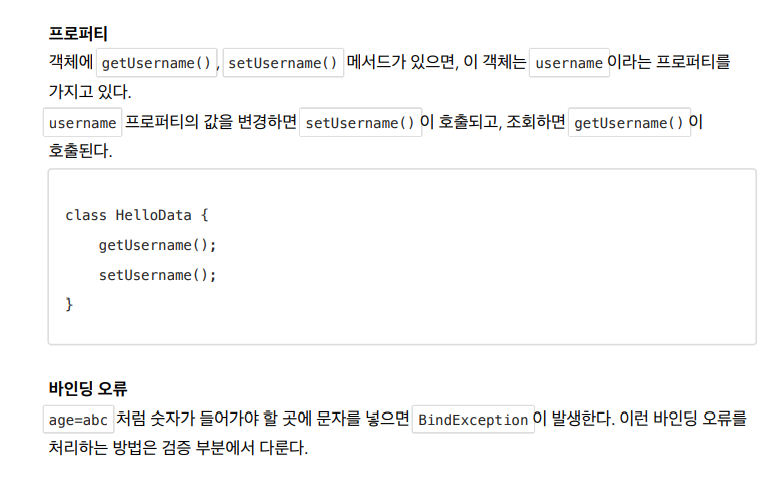
===
@ModelAttribute 생략 - modelAttributeV2
/**
* @ModelAttribute 생략 가능
* String, int 같은 단순 타입 = @RequestParam
* argument resolver 로 지정해둔 타입 외 = @ModelAttribute
*/
@ResponseBody
@RequestMapping("/model-attribute-v2")
public String modelAttributeV2(HelloData helloData) {
log.info("username={}, age={}", helloData.getUsername(),
helloData.getAge());
return "ok";
}
HTTP 요청 메시지 - 단순 텍스트
HTTP message body에 데이터를 직접 담아서 요청
- HTTP API에서 주로 사용, JSON, XML, TEXT
- 데이터 형식은 주로 JSON 사용
- POST, PUT, PATCH
요청 파라미터와 다르게, HTTP 메시지 바디를 통해 데이터가 직접 데이터가 넘어오는 경우는
@RequestParam , @ModelAttribute 를 사용할 수 없다. (물론 HTML Form 형식으로 전달되는 경우는
요청 파라미터로 인정된다.
v1
@Slf4j
@Controller
public class RequestBodyStringController {
@PostMapping("/request-body-string-v1")
public void requestBodyString(HttpServletRequest request,
HttpServletResponse response) throws IOException {
ServletInputStream inputStream = request.getInputStream();
String messageBody = StreamUtils.copyToString(inputStream,
StandardCharsets.UTF_8);
log.info("messageBody={}", messageBody);
response.getWriter().write("ok");
}
}v2
/**
* InputStream(Reader): HTTP 요청 메시지 바디의 내용을 직접 조회
* OutputStream(Writer): HTTP 응답 메시지의 바디에 직접 결과 출력
*/
@PostMapping("/request-body-string-v2")
public void requestBodyStringV2(InputStream inputStream, Writer responseWriter)
throws IOException {
String messageBody = StreamUtils.copyToString(inputStream,
StandardCharsets.UTF_8);
log.info("messageBody={}", messageBody);
responseWriter.write("ok");
v3
/**
* HttpEntity: HTTP header, body 정보를 편라하게 조회
* - 메시지 바디 정보를 직접 조회(@RequestParam X, @ModelAttribute X)
* - HttpMessageConverter 사용 -> StringHttpMessageConverter 적용
*
* 응답에서도 HttpEntity 사용 가능
* - 메시지 바디 정보 직접 반환(view 조회X)
* - HttpMessageConverter 사용 -> StringHttpMessageConverter 적용
*/
@PostMapping("/request-body-string-v3")
public HttpEntity<String> requestBodyStringV3(HttpEntity<String> httpEntity) {
String messageBody = httpEntity.getBody();
log.info("messageBody={}", messageBody);
return new HttpEntity<>("ok");
}
스프링 MVC는 다음 파라미터를 지원한다.
HttpEntity: HTTP header, body 정보를 편리하게 조회
- 메시지 바디 정보를 직접 조회
- 요청 파라미터를 조회하는 기능과 관계 없음
@RequestParam X,@ModelAttribute XHttpEntity는 응답에도 사용 가능
- 메시지 바디 정보 직접 반환
- 헤더 정보 포함 가능
- view 조회X
HttpEntity를 상속받은 다음 객체들도 같은 기능을 제공한다.RequestEntity
- HttpMethod, url 정보가 추가, 요청에서 사용
ResponseEntity
- HTTP 상태 코드 설정 가능, 응답에서 사용
return new ResponseEntity<String>("Hello World", responseHeaders, HttpStatus.CREATED
v4
/**
* @RequestBody
* - 메시지 바디 정보를 직접 조회(@RequestParam X, @ModelAttribute X)
* - HttpMessageConverter 사용 -> StringHttpMessageConverter 적용
*
* @ResponseBody
* - 메시지 바디 정보 직접 반환(view 조회X)
* - HttpMessageConverter 사용 -> StringHttpMessageConverter 적용
*/
@ResponseBody
@PostMapping("/request-body-string-v4")
public String requestBodyStringV4(@RequestBody String messageBody) {
log.info("messageBody={}", messageBody);
return "ok";
}
